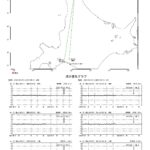2023-06-21 ロスアラモス国立研究所(LANL)
◆噴火によって形成された噴煙は通常の嵐よりも高い高度で雷を発生させ、最大高度に達した後は広がりを見せる円状のリップルを形成しました。この研究は、火山雷光を利用して火山活動を監視する価値を示しています。このような遠隔検出による雷光の観測は、火山噴火のタイムラインを作成する上で非常に役立つ情報を提供しています。
<関連情報>
- https://discover.lanl.gov/news/0620-tongan-volcano/
- https://agupubs.onlinelibrary.wiley.com/doi/10.1029/2022GL102341
稲妻の輪と重力波: 2022年1月15日にトンガのフンガ火山から噴出した巨大噴火プルームに関する洞察 Lightning Rings and Gravity Waves: Insights Into the Giant Eruption Plume From Tonga’s Hunga Volcano on 15 January 2022
Alexa R. Van Eaton, Jeff Lapierre, Sonja A. Behnke, Chris Vagasky, Christopher J. Schultz, Michael Pavolonis, Kristopher Bedka, Konstantin Khlopenkov
Geophysical Research Letters Published: 20 June 2023
DOI:https://doi.org/10.1029/2022GL102341

Abstract
On 15 January 2022, Hunga Volcano in Tonga produced the most violent eruption in the modern satellite era, sending a water-rich plume at least 58 km high. Using a combination of satellite- and ground-based sensors, we investigate the astonishing rate of volcanic lightning (>2,600 flashes min−1) and what it reveals about the dynamics of the submarine eruption. In map view, lightning locations form radially expanding rings. We show that the initial lightning ring is co-located with an internal gravity wave traveling >80 m s−1 in the stratospheric umbrella cloud. Buoyant oscillations of the plume’s overshooting top generated the gravity waves, which enhanced turbulent particle interactions and triggered high-current electrical discharges at unusually high altitudes. Our analysis attributes the intense lightning activity to an exceptional mass eruption rate (>5 × 109 kg s−1), rapidly expanding umbrella cloud, and entrainment of abundant seawater vaporized from magma-water interaction at the submarine vent.
Key Points
- This eruption produced the most intense lightning rates ever documented in Earth’s atmosphere
- Lightning rings expand with enormous gravity waves in the umbrella cloud, caused by buoyant oscillation of the overshooting plume top
- Volcanic lightning and satellite analysis reveal at least four phases of eruptive activity from 02:57–15:12 UTC on 15 January 2022
Plain Language Summary
The eruption of Tonga’s underwater Hunga Volcano culminated on 15 January 2022 with a giant volcanic plume that rose out of the ocean and into the mesosphere. This plume created record-breaking amounts of volcanic lightning observed both from space and by radio antennas on the ground thousands of kilometers away. We show that the eruption created more lightning than any storm yet documented on Earth, including supercells and tropical cyclones. The volcanic plume rose to its maximum height and expanded outward as an umbrella cloud, creating fast-moving concentric ripples known as gravity waves, analogous to a rock dropped in a pond. Point locations of lightning flashes also expanded outward in a pattern of donut-shaped rings, following the movement of these ripples. Optically bright lightning was detected at unusually high altitudes, in regions of the volcanic cloud 20–30 km above sea level. Our findings show that a sufficiently powerful volcanic plume can create its own weather system, sustaining the conditions for electrical activity at heights and rates not previously observed. Overall, remote detection of lightning contributed to a detailed timeline of this historic eruption and, more broadly, provides a valuable tool for monitoring and nowcasting hazards of explosive volcanism worldwide.



